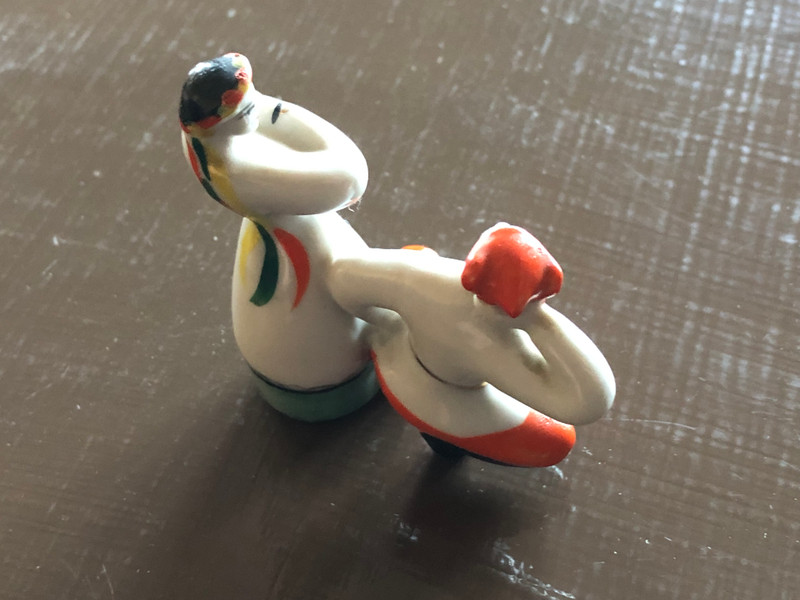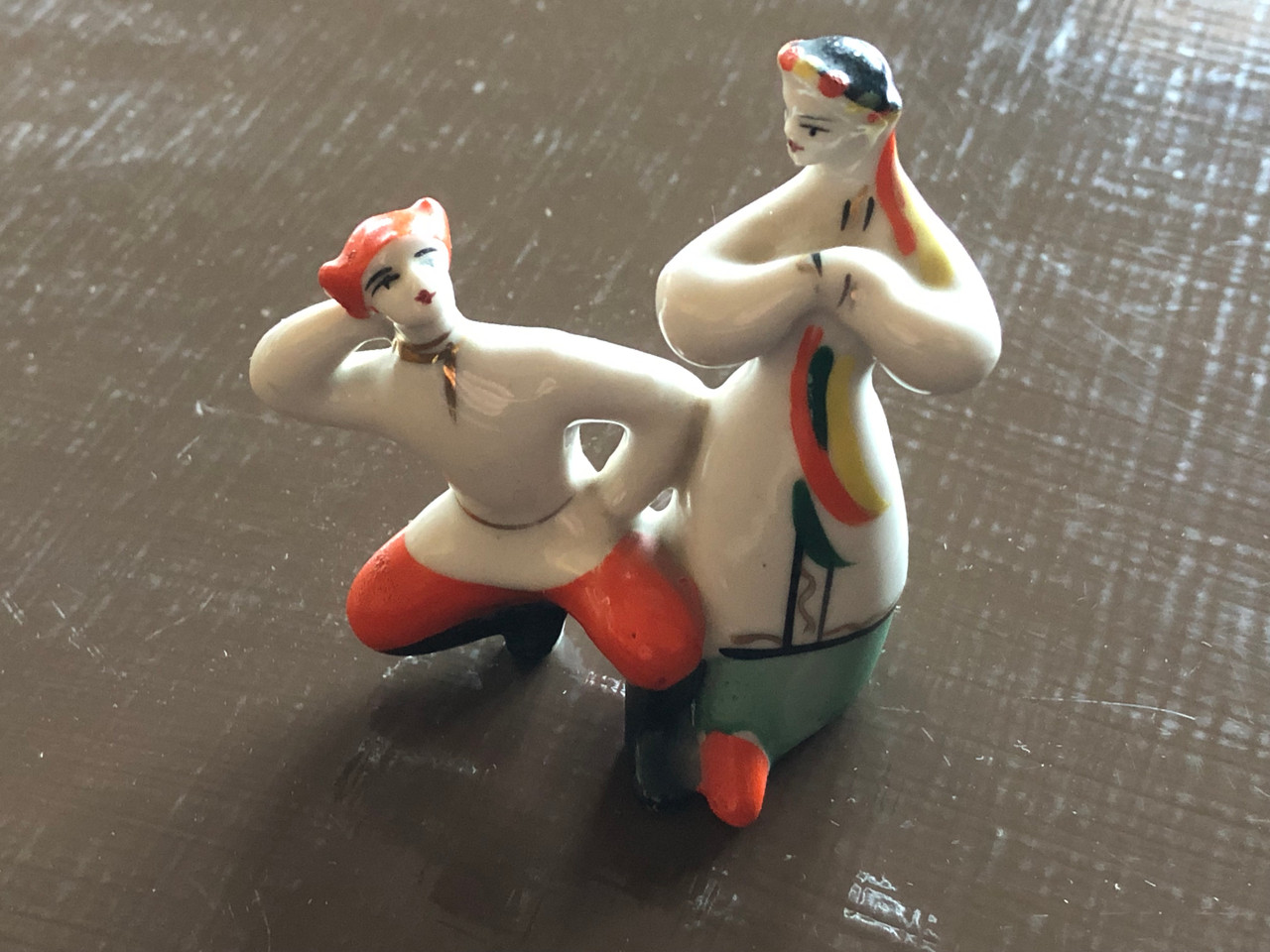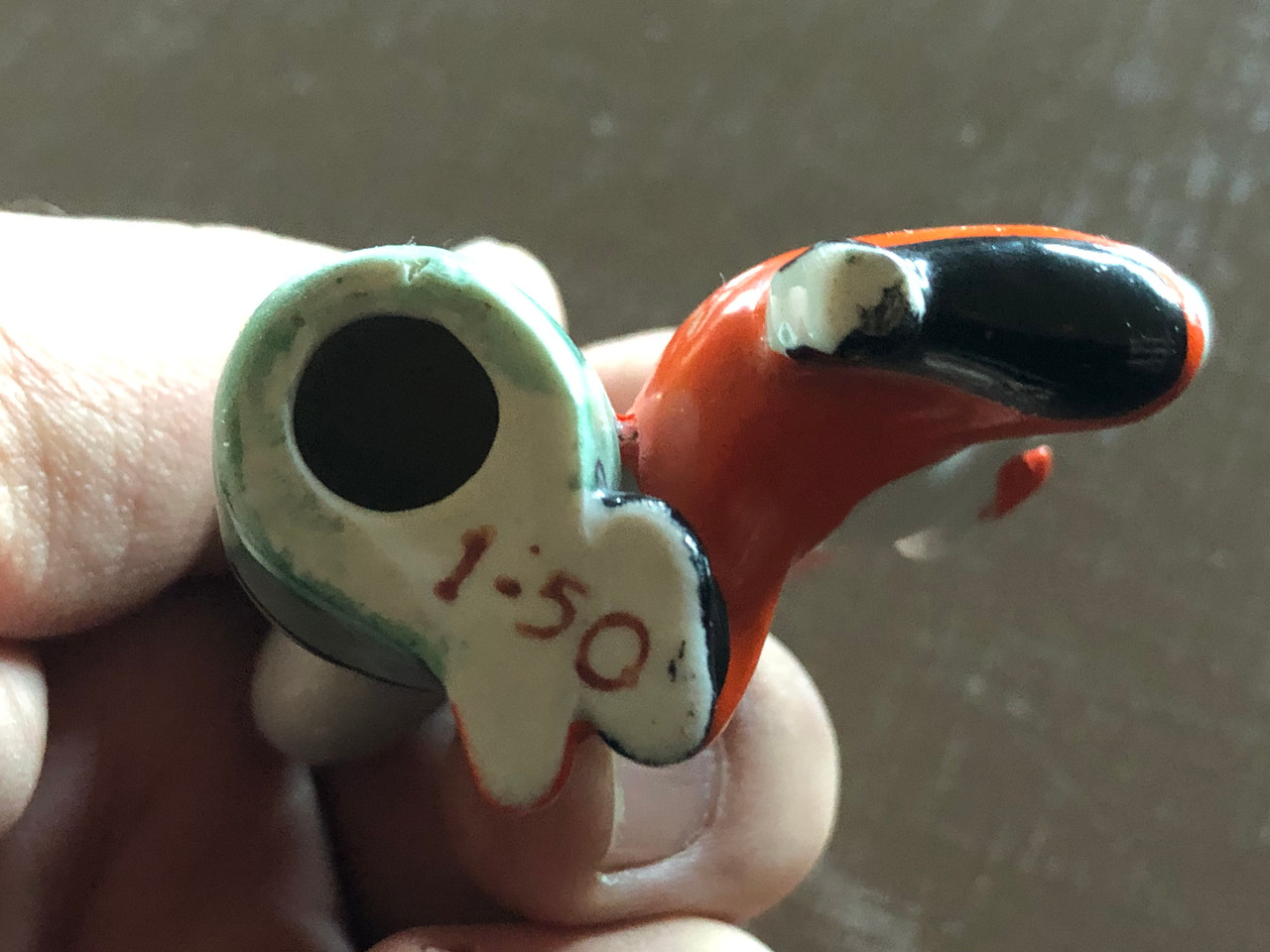Description
Soviet Porcelain Figurine "Gopak" Dance - Vintage Ukrainian Folk Art Statuette (1970s)
Винтажная советская фарфоровая миниатюрная статуэтка под названием «Гопак»
Brand Name: Polonsky Artistic Ceramics Factory (Полонский ЗХК), Ukrainian SSR
Overview
This charming vintage Soviet porcelain miniature figurine titled "Gopak" captures the vibrant spirit of traditional Ukrainian folk dance. Created by renowned sculptor A.S. Cherednik at the Polonsky Artistic Ceramics Factory in Ukraine during the 1970s, this collectible statuette depicts a dancing couple performing the energetic Gopak (also spelled Hopak), one of Ukraine's most beloved national dances. The boy figure is shown in the characteristic squatting position known as "prisiadka," wearing a white shirt, bright orange-red tunic and trousers, and black boots, while his partner strikes a classic dance pose in a traditional sarafan-style dress with green and orange-red accents. Crafted from fine porcelain with overglaze polychrome hand-painting and elegant gold detailing on necklines and waistbands, this miniature sculpture measures 6.4 cm in height (64 x 65 x 30 mm). The figurine features a glossy glaze and bold colors typical of Soviet-era folk art ceramics, with the original retail price marking "1:50" (1 ruble 50 kopecks) visible on the base, confirming its authentic Soviet provenance. In excellent collectible condition with minor storage traces, this piece represents a beautiful example of Ukrainian decorative arts celebrating Slavic cultural heritage during the Soviet period.
Product Features
- Format: Hand-painted porcelain miniature figurine
- Creation Period: 1970s (Soviet era)
- Manufacturer: Polonsky Artistic Ceramics Factory (Полонский завод художественной керамики), Ukrainian SSR
- Sculptor: A.S. Cherednik (А. С. Чередник)
- Title: "Gopak" (Гопак) - Traditional Ukrainian folk dance
- Material: Fine porcelain with overglaze polychrome painting
- Decoration Technique: Hand-painted with gold accents (gilding)
- Dimensions: Height 6.4 cm (64 x 65 x 30 mm)
- Weight: Lightweight porcelain, palm-sized
- Finish: Glossy glaze
- Color Palette: White, bright orange-red, green, black, with gold detailing
- Condition: Collectible condition with traces of storage
- Original Price Marking: "1:50" (1 ruble 50 kopecks) - visible on base
- Style: Soviet folk art, traditional Slavic cultural motif
- Dance Depicted: Gopak/Hopak with characteristic "prisiadka" squatting pose
- Cultural Region: Ukrainian SSR
- Collectibility: Vintage Soviet decorative art, folk culture souvenir
Interesting Facts
The Polonsky Porcelain Factory has a fascinating history dating back to 1889 when it was founded by Moisey Shapiro in the town of Polonnoye (Полонное), Ukraine. Initially, the small enterprise employed only nine workers and produced hand-painted tableware with printed designs and planters. In the late 1890s, management passed to entrepreneur A. Zusman, who strategically shifted production from expensive porcelain to more accessible faience, and after 1900, to sanitary ceramics. The factory thrived in this market segment until the 1917 Revolution disrupted operations.
Between 1919 and 1923, the factory fell into neglect, suffering damage during World War I and the Russian Civil War, with its grounds even being used as a livestock yard. The enterprise was revived in 1923 for sanitary faience production, but in 1933, it completely transitioned back to porcelain manufacturing, marking the beginning of its golden age for decorative arts. During the Soviet period, the factory became known for producing beautiful folk art figurines, tableware, and decorative objects that celebrated regional cultural traditions.
Sculptor A.S. Cherednik was one of the talented artists working at the Polonsky Factory during the 1970s, creating miniature sculptures that captured the essence of Ukrainian folk culture. The "Gopak" figurine exemplifies the Soviet approach to decorative arts—making cultural heritage accessible to ordinary citizens through affordable, mass-produced artistic objects. The gopak (hopak) dance depicted in this figurine is Ukraine's national dance, characterized by its acrobatic male movements including the famous "prisiadka" (squatting dance steps) and energetic leaps, paired with graceful female movements. The dance originated among the Zaporozhian Cossacks and became a symbol of Ukrainian identity and spirit.
The price marking "1:50" (1 ruble 50 kopecks) on the base provides valuable authentication and historical context. This was a standard retail price for smaller ceramic souvenirs in the USSR, making folk art accessible to working-class Soviet citizens. Such figurines were popular as decorative items for home shelves, gifts, and affordable collectibles that promoted Soviet folk culture and regional artistic traditions. The bold colors—bright orange-red, green, white, and black—combined with gold accents reflect the vibrant aesthetic of Ukrainian folk costumes and the optimistic spirit of Soviet decorative arts.
The male figure's costume—white shirt, bright tunic, and black boots—represents traditional Ukrainian male folk dress, while the female figure's sarafan-style dress with colorful ribbons and sash echoes historical Ukrainian women's attire. The minimal facial features and emphasis on costume details and dynamic poses are characteristic of Soviet folk art ceramics, which prioritized capturing movement, color, and cultural authenticity over realistic portraiture.
Today, vintage Soviet porcelain figurines from the Polonsky Factory are sought after by collectors worldwide who appreciate Ukrainian folk art, Soviet-era decorative arts, and cultural historical artifacts. These pieces represent not only artistic craftsmanship but also a fascinating period when folk traditions were preserved and celebrated through accessible decorative objects during the Soviet era.
Historical Context - Polonsky Porcelain Factory
1889: Founded by Moisey Shapiro with 9 workers, producing hand-painted tableware and planters
Late 1890s: Management transferred to A. Zusman, shifted to faience and sanitary ceramics production
1917-1923: Factory abandoned during WWI and Civil War, used as livestock yard
1923: Revival for sanitary faience production
1933: Complete transition to porcelain manufacturing
1970s: Golden age of decorative folk art figurines, including this "Gopak" piece
Present: Collectible vintage Soviet Ukrainian porcelain
Cultural Significance
The Gopak (Hopak) dance depicted in this figurine is Ukraine's national dance, originating among Zaporozhian Cossacks. The characteristic "prisiadka" squatting movements performed by the male dancer and the graceful partnering movements represent Ukrainian cultural identity and the spirit of freedom. These Soviet-era figurines served as cultural ambassadors, preserving and promoting Ukrainian folk traditions while making art accessible to ordinary citizens at an affordable price of 1 ruble 50 kopecks.
Care Instructions
- Handle with care due to delicate porcelain material
- Display away from direct sunlight to preserve hand-painted colors
- Clean gently with soft, dry cloth only
- Avoid water or chemical cleaners that may damage overglaze painting and gilding
- Store in padded environment if not displayed
- Note: Colors may appear differently on various monitors due to screen calibration variations
We value your feedback! Share your experience with this product to help others make informed decisions. Your review is important to us!
#SovietPorcelain #UkrainianFolkArt #GopakDance #PolonskyFactory #VintageFigurine #1970sSoviet #CherednilSculptor #FolkDanceFigurine #SovietCollectibles #UkrainianSSR #VintagePorcelain #SovietDecorativeArts #HopakDance #CossackDance #UkrainianCulture #SovietSouvenir #CollectibleFigurine #HandPaintedPorcelain #FolkArtCollectible #SlavicHeritage #SovietCeramics #UkrainianHeritage #VintageSovietArt #1970sDecor #CulturalFigurine #BuyVintageOnline #RareSovietCollectibles #AuthenticSovietArt #USSRMemorabilia #TraditionalDanceFigurine
Обзор (Russian Translation)
Эта очаровательная винтажная советская фарфоровая миниатюрная статуэтка под названием «Гопак» передаёт яркий дух традиционного украинского народного танца. Созданная известным скульптором А.С. Чередником на Полонском заводе художественной керамики в Украине в 1970-х годах, эта коллекционная статуэтка изображает танцующую пару, исполняющую энергичный гопак, один из самых любимых национальных танцев Украины. Фигура мальчика показана в характерной позе присядки, одет в белую рубашку, яркую оранжево-красную тунику и штаны и чёрные сапоги, в то время как его партнёрша принимает классическую танцевальную позу в традиционном платье в стиле сарафана с зелёными и оранжево-красными акцентами. Изготовленная из тонкого фарфора с надглазурной полихромной ручной росписью и элегантным золочением на вырезах и поясах, эта миниатюрная скульптура имеет высоту 6,4 см (64 x 65 x 30 мм). Статуэтка имеет глянцевую глазурь и яркие цвета, типичные для советской народной керамики, с оригинальной ценовой маркировкой «1:50» (1 рубль 50 копеек), видимой на основании, подтверждающей её подлинное советское происхождение. В отличном коллекционном состоянии с незначительными следами хранения, этот предмет представляет собой прекрасный образец украинского декоративного искусства, прославляющего славянское культурное наследие в советский период.
Интересные факты (Russian Translation)
Полонский фарфоровый завод имеет увлекательную историю, восходящую к 1889 году, когда он был основан Моисеем Шапиро в городе Полонное, Украина. Первоначально на небольшом предприятии работало всего девять рабочих, производивших расписанную вручную посуду с печатными рисунками и кашпо. В конце 1890-х годов управление перешло к предпринимателю А. Зусману, который стратегически переориентировал производство с дорогого фарфора на более доступный фаянс, а после 1900 года — на сантехническую керамику. Завод процветал в этом сегменте рынка до революции 1917 года.
Между 1919 и 1923 годами завод пришёл в упадок, пострадав во время Первой мировой и Гражданской войн, его территория даже использовалась как скотный двор. Предприятие было возрождено в 1923 году для производства санитарного фаянса, но в 1933 году оно полностью вернулось к производству фарфора, что ознаменовало начало его золотого века декоративного искусства.
Скульптор А.С. Чередник был одним из талантливых художников, работавших на Полонском заводе в 1970-х годах, создавая миниатюрные скульптуры, которые передавали суть украинской народной культуры. Статуэтка «Гопак» воплощает советский подход к декоративному искусству — делать культурное наследие доступным для обычных граждан через доступные по цене, массово производимые художественные предметы. Танец гопак, изображённый в этой статуэтке, является национальным танцем Украины, характеризующимся акробатическими мужскими движениями, включая знаменитую «присядку», в паре с грациозными женскими движениями. Танец возник среди запорожских казаков и стал символом украинской идентичности и духа.
Ценовая маркировка «1:50» (1 рубль 50 копеек) на основании предоставляет ценную аутентификацию и исторический контекст. Это была стандартная розничная цена для небольших керамических сувениров в СССР, что делало народное искусство доступным для рабочего класса советских граждан.
Хэштеги (Russian Hashtags)
#СоветскийФарфор #УкраинскоеНародноеИскусство #ТанецГопак #ПолонскийЗавод #ВинтажнаяСтатуэтка #Советские1970е #СкульпторЧередник #СтатуэткаНародногоТанца #СоветскиеКоллекции #УкраинскаяССР #ВинтажныйФарфор #СоветскоеДекоративноеИскусство #ТанецГопак #КазацкийТанец #УкраинскаяКультура #СоветскийСувенир #КоллекционнаяСтатуэтка #РасписнойФарфор #НародноеИскусствоКоллекция #СлавянскоеНаследие #СоветскаяКерамика #УкраинскоеНаследие






























